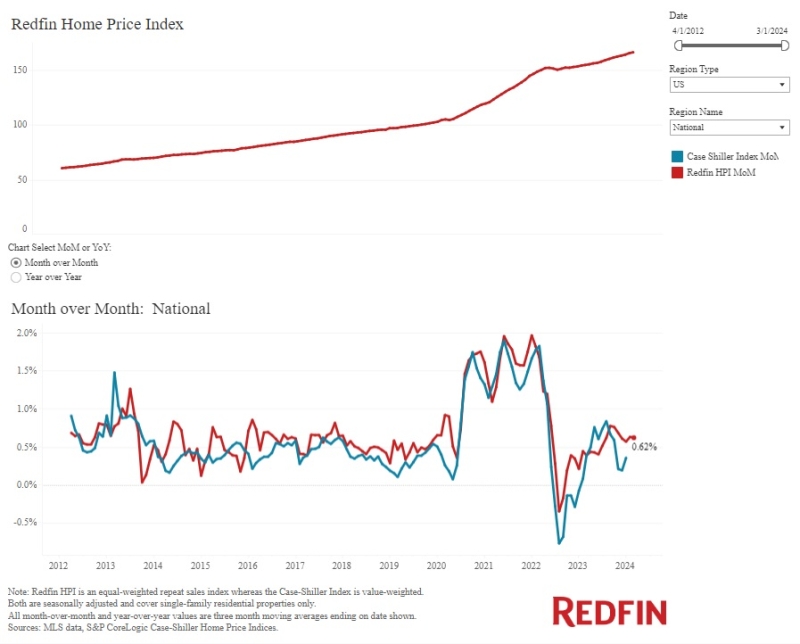Advertisement
NAMB supports bi-partisan effort to establish national uniform lending standards
Home values sizzle and freeze, depending on the regionCharlie Elliott Jr., MAI, SRA2004 home values, home appreciation, regional factors
We hear a lot about home values increasing and how the home is
the best investment that most of us will ever have. It is true that
2004 was one of the best years on record for home price increases,
at least in parts of the country.
This is evidenced by the March report of the Office of Federal
Housing Enterprise Oversight (OFHEO). This organization is a
division of the U.S. Department of Housing and Urban Development
and is the watchdog for the government overseeing the
government-sponsored enterprises (GSEs), which include Fannie Mae
and Freddie Mac. Given their position, they have access to all of
the nationwide housing statistics in each market, and they
regularly produce the Housing Price Index (HPI).
During 2004, home values increased more nationally than they
have in 25 years to an average annual rate of 11.2 percent, reports
OFHEO. Another report coming from the National Association of
Realtors (NAR) reflected an increase of 9.26 percent in the median
sales price of existing homes, rising from an average of $169,500
from the end of 2003 to $185,200 at the end of 2004.
In spite of the skyrocketing prices in many areas of the
country, not all homeowners have been pleased with the rate of
increase in the value of their homes. In some areas of the country,
home value appreciation barely existed; in others, homes increased
in value at a blistering rate, some in excess of 30 percent,
according to OFHEO.
Listed below is a more local metropolitan area breakdown of some
of the changes in home values around the country that fall outside
the mainstream or average values as reported by OFHEO:
Red hot areas:
•Las Vegas 36 percent
•Bakersfield, Calif. 30 percent
•Reno, Nev. 30 percent
•Riverside, Calif. 30 percent
•Visalia, Calif. 27 percent
Ice cold areas:
•Anderson, S.C. one percent
•Sioux City, Iowa one percent
•Columbus, Ind. two percent
•Mansfield, Ohio two percent
•Austin, Texas two percent
You may be asking yourself what the people in Anderson, S.C.,
did to deserve the lowest rating of any metropolitan area in the
country. Furthermore, and perhaps more intriguing, what did the Las
Vegas people have going for them that we did not in our area? There
is probably no one answer since many factors go into determining
home value appreciation. If I had to settle on one, I would "place
my bets" on the local economy. You probably could not help but
notice the reference to gambling in the phrase addressing why Las
Vegas is at the top of the heap. That was no accident. Gambling and
the related economic effects that accommodate it were the engine
that boosted the fortunes of those owning a home near the strip.
Notice that Reno was not far behind its larger sister in our "Red
hot areas."
As for Anderson, S.C., an overall sluggish economy in both
Carolinas has contributed to the lackluster home appreciation. The
area has been plagued with many factory closings in recent months.
This can generally be attributed to competition from overseas in
textiles and related industries.
Perhaps more analysis is in order to get a handle on the
complete spectrum of housing value changes. It would be inaccurate
to portray a small area in Nevada and California as the only area
of the country where substantial home value increases occurred
during 2004. There were many areas that experienced value increases
in excess of 20 percent within the past year. Nor would it be
proper to imply that the Carolinas are the only places experiencing
a near-stagnant housing market. Listed below are a few additional
geographic areas displaying both favorable and unfavorable housing
appreciation statistics as reported by OFHEO:
Hot areas:
•Palm Bay, Fla. 26 percent
•Los Angeles 25 percent
•San Diego 24 percent
•West Palm Beach, Fla. 23 percent
•Port St. Lucie, Fla. 23 percent
Cool areas:
•Youngstown, Pa. three percent
•Saginaw, Mich. three percent
•Indianapolis three percent
•Toledo, Ohio three percent
•Boulder, Colo. three percent
While much could be said for the reasons why this sampling of
geographic areas has displayed hot or cool housing markets, a
couple of key issues come to mind, which should be addressed.
There is a common thread in the hot areas, not all of which is
shown on the sampling above. It seems that our entire country is
obsessed by water properties, both waterfront and near water. It is
no accident that all five of the hot areas listed above are areas
that benefit from their location on or very near the ocean, and
that's not all. Many other areas demonstrating rapid appreciation
are water areas, including Virginia Beach, Va.; Honolulu;
Hagerstown, Md.; and Medford, Ore., all of which had appreciation
rates at or above 20 percent last year. Homes located in rich
playgrounds, resort areas and areas of sunshine are also among the
high appreciation areas. While much of the time these areas are
also near water, they are also basking in appreciation and usually
frequented by those owing two or more homes.
Cool areas are somewhat harder to classify into one group, but
it is fair to say that most are in areas where the economy is
sluggish due to plant closings, layoffs and a general lackluster
economy. Some cities experiencing appreciation rates at or below
five percent in 2004 include Nashville, Tenn.; Detroit; Fort Worth,
Texas; Pittsburgh; Tulsa, Okla.; and Rochester, N.Y.
For those of us wanting to get into the act of making money on
our homes, a few points should be considered. Shy away from buying
homes in areas of high unemployment, lower socioeconomic parts of
town and areas experiencing slowdowns in economic growth. Areas
demonstrating aggressive technology expansion should be favored
over those relying heavily on factory jobs, as many of these jobs
are going overseas. Homes located in or near vacation areas,
beaches, lakes, heavy growth, second homes, etc., are to be given
prime consideration.
Having said all of this, it should be noted that some years are
better than others, and, as with the stock market, a rising tide is
an advantage to all boats. Having just come off a year with very
high tide, caution is advised. It should be further noted that
OFHEO also reported that the last quarter of 2004 demonstrated the
weakest quarter of the year, representing a slowdown from the other
quarters. With interest rates rising, finding the appreciation
niche in housing may be more difficult in 2005.
Charlie W. Elliott Jr., MAI, SRA is president of Elliott
& Company Appraisers, a national real estate appraisal company.
He can be reached at (800) 854-5889, [email protected] or
through the company's Web site at www.appraisalsanywhere.com.
About the author





